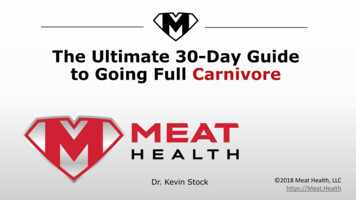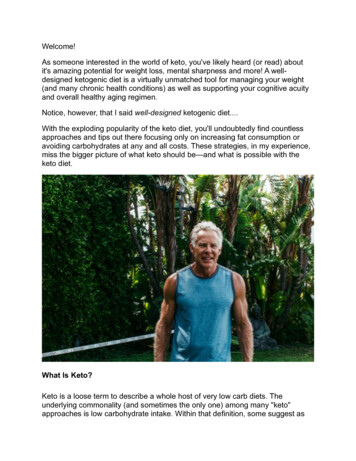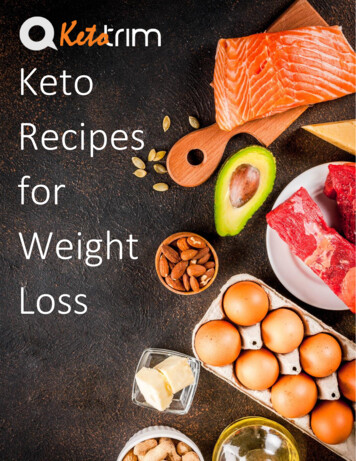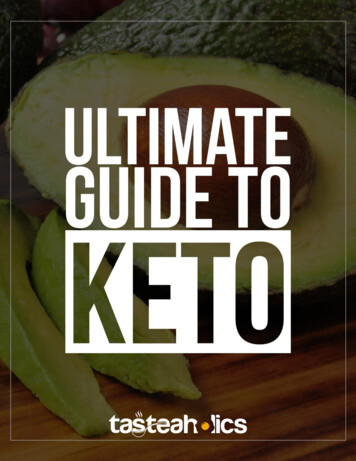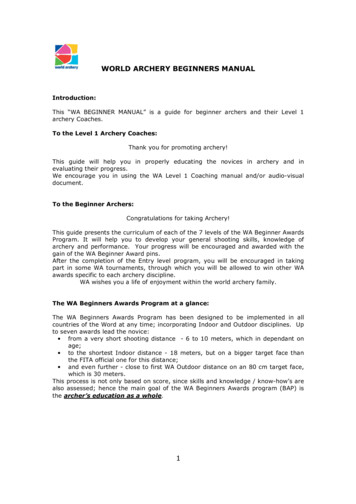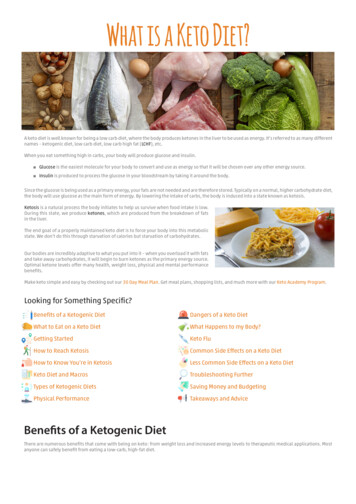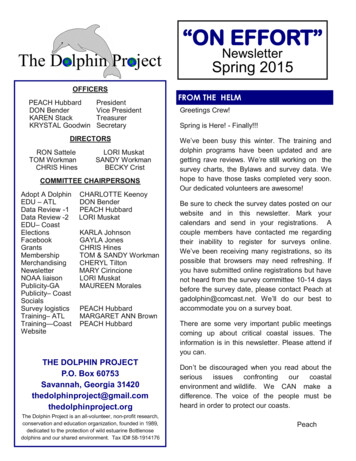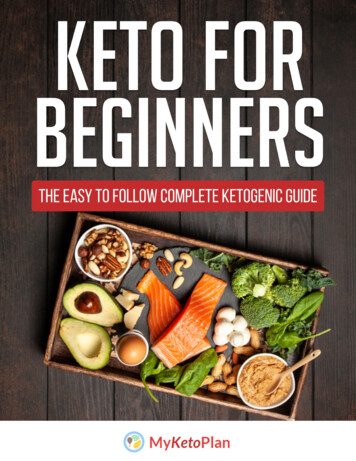
Transcription
KETO FOR BEGINNERS1
KETO FOR BEGINNERSContents1. KETO FOR BEGINNERS . 4WHAT IS THE KETOGENIC DIET? .4WHAT ARE KETONES .4WHAT ARE KETO MACROS? .5HOW TO TELL IF YOU’RE IN KETOSIS.5HOW TO MEASURE KETONES.6TYPES OF KETOGENIC DIETS .7INTERMITTENT FASTING ON KETO .72. UNDERSTANDING NUTRITION LABELS . 8DID YOU KNOW? .83. WHAT TO EAT ON KETO (AND WHAT TO AVOID) . 10KETO ANIMAL FOODS . 10KETO VEGETABLES. 12KETO FRUIT . 14KETO NUTS AND SEEDS . 15KETO DAIRY . 16SATURATED . 18MONOUNSATURATED . 18POLYUNSATURATED . 18TRANS FAT . 18SPICES . 20CONDIMENTS . 21KETO VS. LOW-CARB . 232
KETO FOR BEGINNERS4. IS A VEGAN KETO DIET REALLY A THING? . 245. KETO DIET BENEFITS . 26KETO FOR WEIGHT LOSS. 26POSSIBLE THERAPY FOR NEUROLOGICAL DISEASES . 27ATHLETIC PERFORMANCE . 28OPTIMAL BRAIN FUEL . 29LESS CHRONIC INFLAMMATION . 30LOWER RISK OF HEART DISEASE . 31REVERSING TYPE 2 DIABETES AND MANAGING TYPE 1 DIABETES . 326. WHAT CAN YOU EXPECT WHEN STARTING KETO? . 33KETO FLU (AKA CARBOHYDRATE WITHDRAWAL) . 33WHAT ABOUT NUTRIENT DEFICIENCIES? . 34WHAT ABOUT VITAMIN C ON KETO . 34ATHLETIC PERFORMANCE . 35SIDE EFFECTS OF ENTERING KETOSIS . 35SHOULD YOU TRY KETO? . 36WHAT ABOUT EXOGENOUS KETONES? (KETONE SUPPLEMENTS). 37PEOPLE WITH THERAPEUTIC NEEDS . 37ATHLETES . 37DON’T CHEAT (BUT IF YOU DO, UNDERSTAND WHAT YOU’RE MISSING OUT ON) . 38CONCLUSION . 393
KETO FOR BEGINNERS1. KETO FOR BEGINNERSWhat is the ketogenic diet?The ketogenic diet, or keto for short, is a style of eating that focuses on, first andforemost, keeping carbs very low and secondly, having a high-fat consumption; youmay also hear it referred to as “high fat-low carb” diet. A hallmark of this way of eatingis to put the body into a ‘fat burning state’ whereby the body burns more fat comparedto what you would on a high carb diet. In doing so, your body converts fats into littlemolecules called ketone bodies, which can contribute to ATP (cellular energy). Byteaching the body to rely on an alternate source of energy aside from glucose, we’reable to alter how it uses energy.What are ketonesKetones are molecules formed from the fats, like those released from your belly. Thistends to happen at a higher rate on a ketogenic diet, but only if carb intake issufficiently low, thus forcing your body to rely on an alternative source of fuel — fat.Basically, you turn fat into ketones which, when used for energy, eventually get turnedback into acetyl-CoA, the molecule your cellular ‘engines’ (mitochondria) actually useto make ATP.Ketogenesis is the process of making ketones from fats. When this happens at a highenough rate, you’re said to be ‘in ketosis’. Ketosis is a metabolic state, but there’s notan exact number to tell you when you’re in or out of ketosis.4
KETO FOR BEGINNERSWhat are keto macros?Depending on whether you follow a strict keto or simply a very low-carb diet, yourmacronutrient ratios may differ. Typically, if you’re weight stable, your macronutrientbreakdown will look a little something like this:Your macronutrient and calorie breakdown will also depend on specific goals andlifestyle factors such as sleep, exercise patterns, stress levels, and genetics. Justremember, we’re all unique and have different needs, so it’s important to understandyour lifestyle and tailor your macronutrients to what your body needs.How to tell if you’re in ketosisYour body doesn’t provide you with a clear signal saying “I am in ketosis” to let youknow whether you are or not, and sometimes going off feelings isn’t that easy. Hereare some key physical signs to look out for that will indicate when you’re in ketosis. ‘Fruity’ breath (mostly at the start) Fewer sugar or starch cravings Increased focus Stable energy levels5
KETO FOR BEGINNERSHow to measure ketonesBeing on a keto diet doesn’t mean you have to constantly measure your ketones. Infact, for most people, it makes sense to gain an intuitive sense if you’re ‘in or out’.However, most people will benefit from initially checking and people with medicalconditions requiring a certain ketone level will have to do so regularly. To each hisown.So if you’re not totally sure whether you’re in ketosis, there are a few simple at-homeways to measure your ketone levels that will indicate how ketogenic you are: Urine testing (peeing on a strip) Breath testing (blowing into a device) Blood testing (pricking your finger for a drop of blood)Blood testing provides the most accurate picture of how ketogenic you are, but breathand urine testing can be useful depending on the circumstance.6
KETO FOR BEGINNERSTypes of ketogenic dietsThe ketogenic diet seems pretty straightforward, but there isn’t just one way to goabout it. In order to stick with a diet and have the most favorable outcomes, it’simportant that it fits well with you and your lifestyle, which is why with keto, there area few different options to choose from.Each has a slight variation on carbs vs. fat intake to suit your needs and your healthgoals. Which type of diet you follow will also be determined by if you follow a meat orplant-based diet. When choosing which one you like best, make sure you have cleargoals in mind. It may take some experimentation in order to find what works for you.The standard ketogenic diet (SKD)The targeted ketogenic diet (TKD)The cyclical ketogenic diet (CKD)The carnivorous or higher-protein ketogenic dietIntermittent fasting on ketoFor people new to the ketogenic diet, intermittent fasting can seem quite daunting.But let us tell you, it’s nothing to fear. While going longer periods of time withouteating can seem absolutely horrible, it doesn’t have to be and is in fact quite liberating.So what is intermittent fasting? It’s simply the idea of rearranging your eatingschedule to allow your body to go anywhere from 12 to 16 hours without foodthroughout the 24 hour day.But there isn’t just one way to do intermittent fasting. You can work it to fit into yourschedule — whether it’s the 16/8 method, alternate day fasting, the 24-hour method,or one meal a day, IF adapts to you and your needs.If you’re curious about intermittent fasting, it’s a great thing to incorporate with theketogenic diet. Why is this? Because a well-formulated keto diet helps to normalizeappetite, which tends to naturally move people into intermittent fasting.7
KETO FOR BEGINNERS2. UNDERSTANDING NUTRITION LABELSReading nutrition labels is something thatseems like common sense, but it canactually be a little deceptive if you’re notentirely sure what you’re looking for. Andespecially with the ketogenic diet, whereyou’re trying to avoid bad fats like seedoils and ‘hidden’ carbs, being able to readand understand nutrition labels is crucial.There are a few basic categories youshould be able to recognize: Serving sizeCalories (and calories from fat)Total FatSaturated fatTrans-fatPolyunsaturated fatMonounsaturated fatTotal carbohydratesFiberSugarProteinDid you know?Fibre is only found in plant foods, right? Nope! There’s such a thing as animal fiber andyou’ve probably already had some. Animal fibre is all the ligaments, tendons, andbones you might get from caned sardines. Or when gnawing the last bits of rib-eyeoff a bone. Eating animals ‘nose-to-tail,’ so to speak, is another way of gettingfermentative substrates in (also known as fiber).It’s also important that you not only know what the macronutrient content of yourfood is, but what is in your food. Make sure that before you buy a product, you knowwhat the ingredients are. Foods are packaged to appear healthy, but when youactually read the ingredients, you’ll see that they sometimes aren’t.8
KETO FOR BEGINNERSHere are three suggestions to remember when looking at an ingredient list:1. the fewer the ingredients, the better;2. watch out for the dozens and dozens of different names for starches andsugars; and3. avoid all products with seed oils (but animal fats, olive oil, butter, and coconutoil are fine). And while you may think being labelled as “organic” or “all natural”makes it healthy, these terms are actually meaningless. Sugar is sugar, whetherit’s organic or not.Try to buy whole, fresh foods, which should be the bulk of your diet – they might noteven have a label. However, when you’re starting out with the ketogenic diet, learninga few examples of the calorie, carb, and fat content of the typical foods you’ll be eatingis useful.EXAMPLE 1:Eggs (2% carbs / 35% protein / 63% fat) and Bacon (0% carbs / 11% protein / 59%fat)EXAMPLE 2:Salmon (0% carbs / 60% proteins / 40% fats), Avocado (19% carbs / 4% protein / 77%fat), Rocket lettuce (93% fiber), Tomatoes (70% carbs / 12% protein / 9% fat)The idea is that you will eventually tune into your body and notice how much you eataccording to your real hunger rather than your cravings for high-sugar foods (e.g.bananas, dates) and junk-foods (e.g. ice cream, pizza, donuts, “sports” bars).9
KETO FOR BEGINNERS3. WHAT TO EAT ON KETO (AND WHAT TO AVOID)There are millions of products on the market targeted at pretty much every type ofdiet you could think of. As the ketogenic diet has become increasingly popular, thereare, of course, also products marketed to those who follow keto. Let’s check what fitinto the keto diet food list:But for now, we’re going to give you a run-down of what’s keto-approved and what’snot.Keto Animal foodsThere are plenty of animal food options when following a ketogenic diet. These foodsare typically thought of as the ‘protein’ in one’s diet. It’s true in the sense that you getthe full range of essential amino acids from them, but they’re more than that – youalso get tons of vitamins, minerals, and essential fatty acids too.10
KETO FOR BEGINNERSTo support local farmers and regenerative agriculture, try getting pasture-raisedmeats when possible. Healthwise, there might not be that big a difference betweenfeedlot and pasture-raised animals. However, feedlot cows are given way too manyantibiotics, so even if they don’t show up in the meat to a significant degree, ‘overmedicated’ cows shouldn’t be subsidized.Importantly, rather than choosing lean cuts of meat, go for the fattier cuts — not onlywill they add flavor, but they’ll help boost your fat intake! By this we mean darker cutsof poultry, ribeye, blade roasts, pork belly, or a high-fat content ground beef (e.g. 85/15as opposed to 90/10). When it comes to animal protein, your options aren’t limited.Here’s a short list of some choices:Animal foodKeto ScoreInsulin els6/1038%Beef Liver8/1036%Be careful when buying cured meats and sausages, as they can often contain addedsugar, fillers, emulsifiers and other additives of a suspect or unknown effect(s) — allthings you want to avoid on the ketogenic diet, or any diet for that matter. As aresponsible consumer, please do your best to buy animal-sourced foods fromsustainable and ethical businesses (e.g. pasture raised pigs) rather than the typicaland cruel industrial operations.11
KETO FOR BEGINNERSProtein shakes can also be a way of getting high-quality protein, but these don’timpact appetite as normal whole food do, which can lead to higher intakes andultimately reduce your blood ketones from their usual or desired level.Keto VegetablesWhen it comes to vegetables, your options are far from limited. Vegetables are astaple to the keto diet for anyone who enjoys them and suffers no plant-triggereddigestive issues. And as long as they don’t displace too many essential animalsourced foods, they’re fine. However, not all vegetables are created equal. It’simportant to have a rough estimate of the net carb count of vegetables and limit thosethat are on the higher end of the scale.Need some ideas of what’s good to consume? As a rule of thumb, stick to vegetablesthat are grown above ground, as their carb count is often significantly lower.VegetableKeto ScoreInsulin 39%Peppers7/1037%12
KETO FOR russel sprouts6/1038%Mushrooms white6/1042%Green beans6/1038%Bok %Ginger5/1051%While keto limits, but doesn’t exclude, the consumption of root vegetables, there area few choices that make it easier to stay ketogenic. But remember, keep tabs on thenet-carb count to ensure you stay within your limit.With fruit, we have to be a little more cautious. Fruit contains natural sugars and isrelatively high in carbohydrates with respect to its macronutrient composition.13
KETO FOR BEGINNERSHowever, a handful or two of berries won’t be a problem for most people on a ketodiet. But things like dates, bananas, and raisins are more concentrated sources ofsugar and are much more likely to increase your insulin enough to lower your bloodketones below 0.3 – 0.5 mmol/L blood ketones (BhB).Keto FruitSo keto does limit your choice of fruit somewhat. If fruit will be a part of your diet, it’sbest to stick to those with a low-glycemic score that will have minimal impact oninsulin, as well as those that have very few net-carbs.Here’s a list of what’s more keto friendly, especially if just starting out with this wayof eating:FruitKeto ScoreInsulin seberries7/1034%Coconut9/107%Lemon Slice8/1023%Plum5/1051%14
KETO FOR BEGINNERSWhile following keto, it’s best to avoid fruits with a high net-carb (and lower fibercount). The higher the net-carb count, the more likely you are surpass your daily carbthreshold, which leaves less for the remainder of the day.It’s also important to avoid fruit juices, fruit concentrates, and dried/dehydrated fruit,as both the calorie count and sugar count (therefore net-carb count) is concentrated.While dried fruit may seem like a healthy snack option, the process of dryingconcentrates the sugars and gives them a higher carbohydrate count by weight.Keto Nuts and seedsNuts and seeds are a decent source of protein and a good source fat, but it’s importantto remember that they also have carbs.Raw and organic give you the best chance of avoiding insecticides and fungicides, aswell as any oxidized seed oils used to roast them.Coconut flour and almond flour can be used as grain flour substitutes. They’reespecially good for gluten intolerant or people with Celiac disease. Unlike normalwhite or whole wheat flour, nut flours may need to be cooked differently. So check therecipe before wasting a batch of ingredients!Keep in mind though, if you’re dealing with inflammatory issues, you may want toavoid almond, chia, or flax seed products entirely. This is because the concentrating,grinding, and heating of PUFAs necessary to make flour seems to excessively oxidizedthe delicate oils.15
KETO FOR BEGINNERSWhen it comes to nuts and nut flours, they’re not all low-carb. Here are your bestoptions:NutsKeto ScoreInsulin t Flour9/1014%Next time you find a recipe that calls for a breading or a cup of a specific flour, don’tworry! Even your favorite recipes and baked goods can be made keto by littlesubstitutions and modifications.keto DairyDairy is one of those grey areas when it comes to paleo and primal, but it doesn’t needto be. Paleo is shorthand for ‘properly adapted to’ and many people do fine with dairy,even though no caveman ever had any. So exclude it for a few weeks and reintroduceit to see if you’re better off with or without it.16
KETO FOR BEGINNERSSo assuming you tolerate dairy products well, go for it! Just don’t make dairy a biggerpart of your calories than your meat or fish intake. Try to buy full-fat and raw dairy.Finding raw dairy is much easier in Europe than the United States due to laws andrestrictions. You also want to avoid low-fat or nonfat dairy products, as they are ladenwith additives to replace the fat. Stick to full-fat dairy to increase health benefits andsatiety.If you’re going through a fat loss stall and you’ve never tried reducing or eliminatedairy for a few weeks, that’s worth a try.While not inclusive, here are some good options:DiaryKeto ScoreInsulin IndexHeavy Cream10/104%Ricotta8/1018%Cottage Cheese7/1029%Cream Cheese9/109%Mascarpone10/104%Fresh 014%Milk7/1038%As fats will comprise a large portion of your diet, you’ll want to figure out which arethe best kinds to consume. Being keto doesn’t mean you have to eat chunks of butteror drown yourself in coconut oil. There are plenty of ways fats can be incorporatedinto the diet — roasting, fat bombs, salad dressing, sauces, any way you’d like!17
KETO FOR BEGINNERSFats are crucial to proper body function, but if sources of concentrated fat displacetoo many sources of fat from whole animal foods, then this can stop fat loss. In theketogenic diet, we focus on a few main kinds of fat:SaturatedDespite everything you’ve probably heard about saturated fat, don’t be afraid of it.You’ll find it in food like meat and seafood, butter, lard, tallow, coconut products anddairy! All of these are good.MonounsaturatedFound in products like pork, beef, fish, olive oil, and of course olives, avocados, nutsand seeds, monounsaturated fats are also great for you so. Enjoy them!PolyunsaturatedThere’s a difference between naturally occurring polyunsaturated fats found in meat,nuts and fruit versus the concentrated sources like seed oils (e.g. sunflower oil,soybean oil, peanut oil, linseed oil, and corn oil). Make sure you diligently avoid them.Trans fatThese industrial fats are the product of processing and chemical alteration thatrenders them highly unhealthy. Naturally occurring ruminant-derived trans fats,however like CLA, are perfectly healthy.The ketogenic diet, while part of it is about high-fat consumption, isn’t just aboutloading up your plate with every type of fat you can find. It’s important to recognizewhat types of fats are present in various foods, how much we’re actually consuming,and getting a tasty range. This is especially true if you’re looking to lower yourexcessive omega-6 intake from seed oils, thereby improving your omega-6 to omega3 ratio.18
KETO FOR BEGINNERSIn a typical diet, the ratios of these two fats are significantly skewed towards omega6s. While both are necessary and play important signaling roles, omega-3 fats areanti-inflammatory precursors and the omega-6 are pro-inflammatory ones. An easyrule of thumb is 1. avoid seed oils, and 2. eat lots of fatty red meat and fatty seacreatures. This will improve your system’s immune response now that you’ve removedsources of chronic inflammation.Wondering what types of fat are good choices? Here are some for you: Olive oil Coconut oil Avocado oil Olives Nuts and seeds Low-PUFA nut butters Lard (preferably pastured) Tallow (preferably grass-fed) Duck fat MCT oil Ghee Butter Mayonnaise (made with high-quality avocado or olive oil) Avocado Egg yolksBe careful with your choices for cooking, however. If you tend to use high heat, stickto fats and oils that have high smoke points like lard, ghee and coconut oil to avoidburning delicate fats.19
KETO FOR BEGINNERSSpicesHow do you make bland food taste good? It’s all about the spices. With keto, thereisn’t much in the spice department that’s off limits. Fresh or dried, both are greatadditions to any recipe.Here are a few fresh herbs that are both delicious and pack both a flavor andnutritional punch: Parsley Cilantro Rosemary Thyme Sage MintDon’t have fresh herbs on hand? Try these ones dried: Basil Cumin Coriander Cinnamon Oregano Allspice Nutmeg Curry Cayenne Chili Dill20
KETO FOR BEGINNERSNot interested in just dusting spices on your food? How about combining them withsome olive oil and marinating your meat? Or throw them into a sauce to give yourmeal a flavor-packed saucy punch. The options are endless when it comes to how youcan use them in different combinations.Herbs and spices are nearly calorie and carb-free.CondimentsThis is one of the trickiest areas to navigate when going keto. Your standardcondiments like ketchup, relish, BBQ sauce, and even some mustards are generallyfull of sugar and additives. While we’re not saying eliminate them altogether, makesure you’re checking the nutrition facts before you go wild.Here are some sauces and condiments that might be safe for you: Mustard Horseradish Hot sauce Sauerkraut Mayonnaise (made with olive oil instead of seed oils) Soy sauce Salad dressings (full-fat, organic)Better yet, why not try making your own condiments and sauces! For example, ifyou’re looking for a topping for steak, why not try a beurre blanc, browned butter, ormustard butter sauce (garlic, mustard, and butter). Sauces and condiments don’t haveto be complicated or full of sugar. Sometimes simple is better.Now that we’ve covered what is okay to eat on a ketogenic diet, we have to coverwhat’s generally not okay.Grains: These are a big no-no on a well-formulated keto diet and should be strictlyavoided. Any wheat-based product like cereal, pastries, bread, and most sweets arefull of carbohydrates and should be avoided. This includes whole grains and pseudograins like buckwheat, quinoa, rye, barley, oats, and the like.21
KETO FOR BEGINNERSLegumes: Just like grains, legumes are high in carbohydrates and should be avoided.They are more nutritious compared to grains but not compared to animal-sourcedfoods. This includes beans like chickpeas, black beans, lentils, kidney beans, and yes,even peanuts. If you have food sensitivities, avoid them. However, you may have asmall side portion and still stay ketogenic if your high insulin sensitive, carry quite abit of muscle mass, or just finished exercising hard.Industrial seed oils: Often highly processed, industrial seeds oils should be strictlyavoided whenever possible due to the risk of oxidation and rancidity.Low-fat products: With a keto diet, our aim so to go high fat, so why would you wantlow-fat? Avoid these products as they’re loaded with unhealthy additives to replacethe fat and mess with your appetite regulation system.Sugar: Strictly avoid sugar and especially products with added sugars. It’s found ineverything from juices and soda to sauces and cereals. If you’re buying pre-packagedfood, make sure you read the label to ensure there are no added or hidden sugars. Ifyou want sweetness, then look for products containing natural sweeteners like xylitol,erythritol, or stevia instead. They may be suitable for you if you experience noadditional cravings or digestive distress from their consumption. Once more,experiment!Fruits: Despite being a natural, whole food, most fruits are bred to be sugar bombs.Opt for the low sugar options mentioned above like berries.Starchy vegetables: This includes root vegetables like potatoes, yams, and sweetpotatoes. Small occasional portions of moderately starchy vegetables like carrots andparsnips will allow you to stay ketogenic if you’re not too insulin resistant (seevegetable section above).Some people think eating keto is highly restrictive; it is in that you really have to restrictjunk-food, but it isn’t in that there are so many others options available (animalsourced foods, dairy, non-starchy vegetables, and some low-sugar fruit).We’ve given you a rundown on what’s keto and what’s not. Let us tell you, we thinkthe “eat these” list doesn’t look so bad. Mix up your food combinations, add somespices and experiment! Keto doesn’t have to be all about eating fat, especially notduring the fat loss phase. Get creative with your meals and come up with new,exciting, and delicious ways to eat keto.22
KETO FOR BEGINNERSKeto vs. Low-CarbKeto and low-carb diets are often used interchangeably, but there’s actually adifference between them.As we mentioned earlier in this guide, ketosis is a metabolic state whereby the bodyburns fat for fuel and ketones are produced at a higher rate such that their blood levelsare higher. Traveling through the blood, t
The ketogenic diet, or keto for short, is a style of eating that focuses on, first and foremost, keeping carbs very low and secondly, having a highfat consumption; you - may also hear it r
